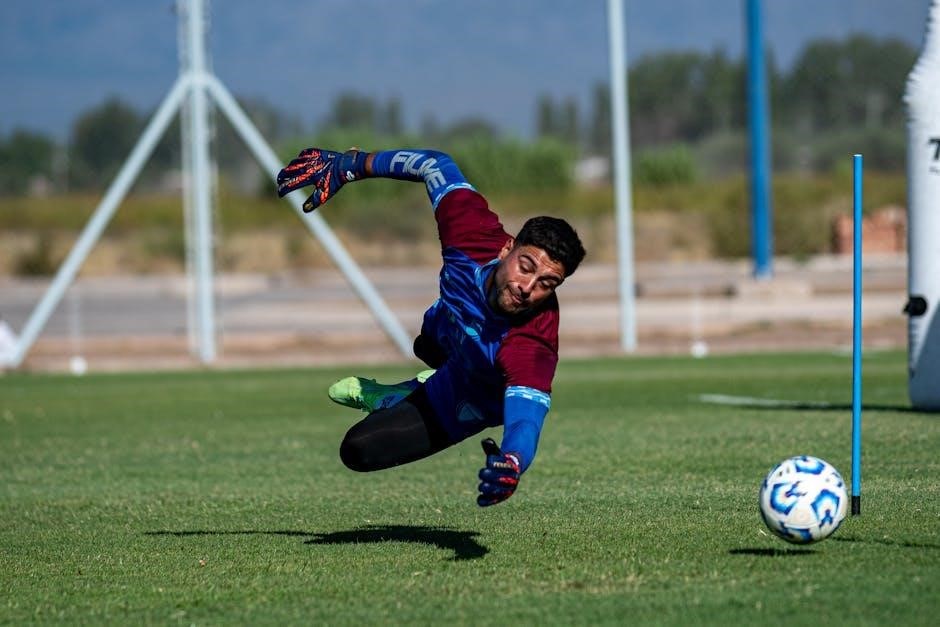
soccer goalkeeper training drills pdf
Effective goalkeeper training drills are essential for developing the unique skills required in this position. These structured exercises improve reflexes, agility, and decision-making, ensuring optimal performance on the field.
1.1 Importance of Goalkeeper-Specific Training
Goalkeeper-specific training is crucial for developing the unique skills required for this position. Unlike outfield players, goalkeepers need specialized drills to enhance reflexes, positioning, and ball handling. Proper training ensures they can react quickly, dive effectively, and communicate with the team. Drills like cone exercises and reaction training are tailored to improve agility and decision-making. These exercises also build confidence, a key factor in high-pressure situations. With dedicated goalkeeper training drills, players can master techniques such as catching, diving, and distributing the ball, making them indispensable to the team’s success. Regular practice helps goalkeepers adapt to different game scenarios and perform at their best.
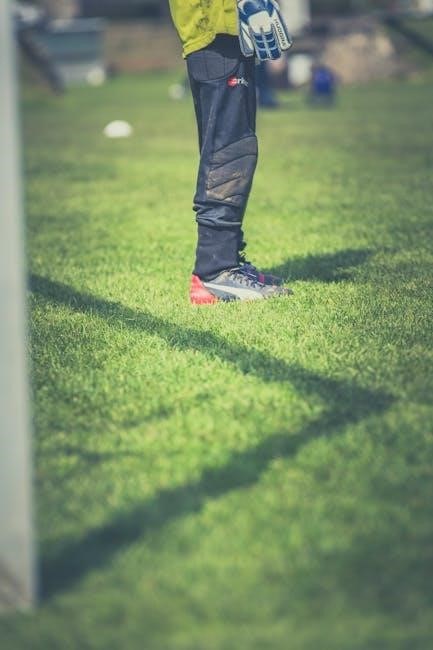
1.2 Overview of Key Skills for Goalkeepers
Goalkeepers require a combination of physical and mental skills to excel. Agility and quick reflexes enable fast movements and sharp reactions. Strong hand-eye coordination is essential for catching and parrying shots. Proper positioning and anticipation help in reducing the angle of shots. Effective communication with the defense is crucial for organizing the team. Footwork and distribution skills, such as accurate throwing and kicking, are vital for restarting play. Mental toughness and focus ensure goalkeepers remain composed under pressure. These skills collectively make a goalkeeper a reliable last line of defense, capable of making game-changing saves and leading their team to success.
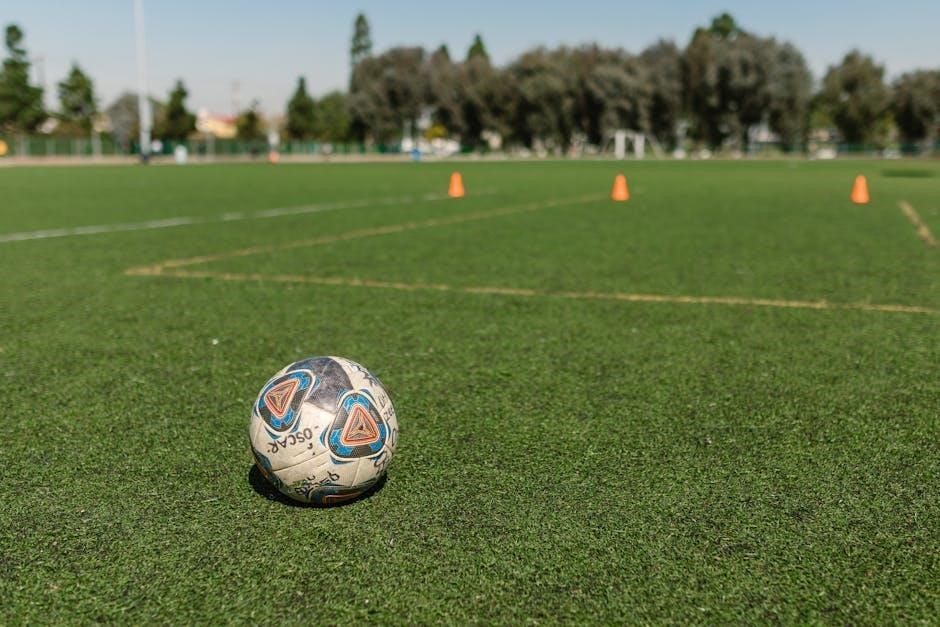
Warm-Up and Basic Drills
A proper warm-up for goalkeepers includes dynamic stretching and light cardio to prepare muscles. Basic drills focus on footwork, ball handling, and fundamental movements essential for the position.
2.1 Dynamic Stretching for Goalkeepers
Digital stretching is crucial for goalkeepers to enhance flexibility and mobility. Drills include leg swings, high knees, and arm circles to prepare the body for explosive movements. Incorporating dynamic stretches like lunges and hip openers improves range of motion, reducing injury risk. Goalkeepers should focus on movements that mimic game situations, such as lateral shuffles and carioca drills, to simulate match-day actions. These exercises increase blood flow and warm up the muscles, ensuring the goalkeeper is ready for high-intensity drills and game scenarios. Dynamic stretching should be performed before every training session and match to maximize performance and prevent muscle strains.
2.2 Ball Handling and Footwork Drills
Ball handling and footwork drills are fundamental for goalkeepers to master control and precision. Drills like cone weaves and figure-eight dribbling improve agility and coordination. Goalkeepers practice rolling, bouncing, and throwing the ball to enhance accuracy and speed. Footwork patterns, such as shuffles and carioca drills, are incorporated to simulate game scenarios. These exercises strengthen the goalkeeper’s ability to move effectively while maintaining ball control. Age-specific drills, such as those for U8 to U16 players, ensure appropriate skill development. Proper ball handling and footwork training are essential for building a solid foundation in goalkeeping, allowing players to react quickly and confidently during matches.
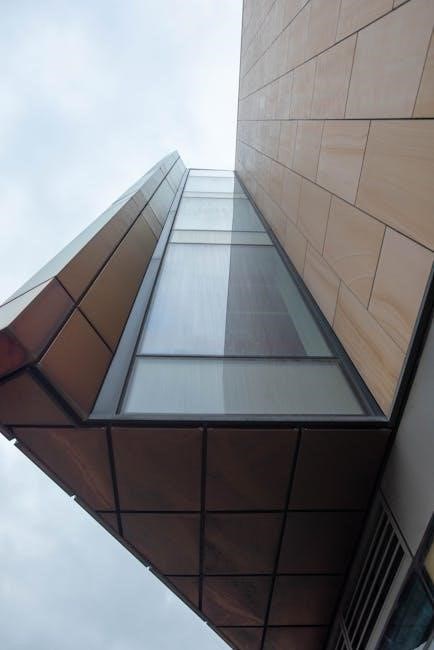
Footwork and Agility Drills
Footwork and agility drills enhance a goalkeeper’s speed and coordination. Ladder drills improve quick steps, while cone exercises focus on sharp turns and rapid changes of direction, boosting reaction time and overall agility for in-game movements.
3.1 Ladder Drills for Agility
Ladder drills are essential for improving a goalkeeper’s agility and quick footwork. These drills involve placing a ladder on the ground and performing various step patterns, such as high knees, lateral shuffles, and carioca drills. Goalkeepers weave through the ladder’s rungs with precision, focusing on rapid movements; The drills enhance speed, coordination, and balance, which are critical for making sharp, game-saving reactions. By incorporating ladder drills into training, goalkeepers can develop the agility needed to cover the penalty area effectively and respond to fast-paced situations during matches. These exercises are simple yet highly effective for building the necessary foot speed and dexterity.
3.2 Cone Drills for Quick Movements
Cone drills are a dynamic way to enhance a goalkeeper’s agility, speed, and reaction time. By setting up cones in zigzag or circular patterns, goalkeepers can practice quick, sharp movements. Drills include weaving through cones, performing figure-eight patterns, and rapid changes of direction. These exercises simulate the fast-paced nature of a match, helping goalkeepers develop the ability to shift positions swiftly. Incorporating reaction commands, such as calling out colors or numbers, adds an element of unpredictability, mimicking game scenarios. Cone drills improve foot speed, balance, and the ability to make sharp, decisive movements, all of which are vital for effective goalkeeping.
Handling and Catching Techniques
Mastering essential catching and handling techniques is vital for goalkeepers. Proper grip, body positioning, and absorption are key. Drills focus on high balls, crosses, and distribution to build confidence and prevent injuries.
4.1 Basic Catching Techniques
Mastering basic catching techniques is fundamental for goalkeepers. Start with the “W” grip, ensuring fingers spread evenly. Focus on meeting the ball with firm hands and cushioning it. Practice catching high balls, low balls, and shots with both hands. Drills include high ball catches, basic handling exercises, and partner throws. Emphasize proper body positioning and balance. Build confidence by gradually increasing difficulty and speed. These foundational skills reduce injury risks and improve reliability in matches. Consistent practice ensures goalkeepers can securely handle various types of shots and crosses, laying the groundwork for advanced techniques. Keep sessions dynamic and focused.
4.2 Advanced Handling Drills
Advanced handling drills refine a goalkeeper’s ability to manage high-intensity situations. Incorporate rapid-fire shots from varying angles, focusing on quick reactions and precise catches. Use the “V” grip for better ball control and accuracy. Practice one-handed catches for difficult saves, ensuring proper body alignment. Introduce drills with multiple shots in quick succession to simulate game-like chaos. Include high-speed crosses and powerful strikes to test reflexes and strength. Pair goalkeepers for chest and thigh passes, emphasizing quick distribution. These drills enhance decision-making, hand speed, and confidence under pressure. Ensure proper technique to avoid injuries and maintain consistency in performance. Keep drills dynamic and challenging.
Diving and Saving Drills
Diving drills focus on mastering proper techniques for safe and effective saves. Drills improve reaction time and reflexes, ensuring quick responses to high-speed shots and crosses.
- Focus on diving techniques for safe and effective saves.
- Improve reaction time and reflexes for quick responses.
5.1 Proper Diving Technique
Proper diving technique is essential for goalkeepers to make effective saves while minimizing injury risk. The goalkeeper should start with a slight knee bend, explosively jumping forward or sideways off one foot.
- Body alignment: Keep the body straight, with hands leading the dive and arms extended to catch the ball.
- Landing technique: Roll with the dive to absorb impact, distributing weight evenly across the shoulders and hips.
- Finger spread: Ensure fingers are spread wide to securely grasp the ball upon contact.
- Practice drills: Focus on diving to both sides, working on balance and precision.
5.2 Reaction Time and Diving Drills
Improving reaction time and diving skills is critical for goalkeepers to excel in high-pressure situations. Drills should simulate game-like scenarios, such as sudden shots or crosses, requiring quick decision-making.
- Reaction ball drills: Use a reaction ball or a coach’s random throws to test the goalkeeper’s ability to react swiftly.
- Divided court drills: Split players into teams for small-sided games, focusing on rapid responses to shots and passes.
- Shuttle runs with dives: Combine footwork and diving by having the goalkeeper move between cones and dive to save shots.
- Progressive difficulty: Start with slower-paced drills and gradually increase speed to mimic real-game intensity.
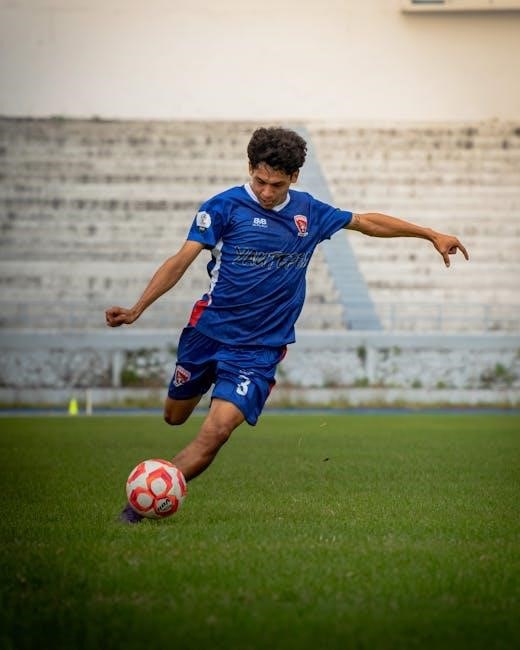
Reaction and Reflex Training
Enhance goalkeepers’ ability to react instinctively with drills focusing on quick movements, explosive power, and sharp reflexes. Essential for making split-second saves and dominating the box.
6.1 Medicine Ball Drills for Core Strength
Medicine ball drills are essential for building the core strength and stability goalkeepers need to explode into saves and maintain balance. Start with basic throws against a wall or with a partner, focusing on explosive power and proper technique. Incorporate rotational movements, such as twisting throws, to mimic the turning motion required in goal. Progress to dynamic drills like Medicine Ball Slams and Tosses, which enhance explosiveness and reaction speed. These exercises improve core engagement, essential for diving, jumping, and quick changes of direction. Aim to include medicine ball workouts 2-3 times weekly for optimal results.
6.2 Reaction Ball Drills for Quick Reflexes
Reaction ball drills are designed to enhance a goalkeeper’s ability to react swiftly and unpredictably, mirroring real-game scenarios. Use a reaction ball, which has an irregular bounce, to simulate unpredictable shots or passes. Start with a coach or teammate dropping the ball, requiring the goalkeeper to react instantly and make sharp reflex saves. Progress to drills where the ball is rolled or thrown with varying speeds and angles, forcing quick decisions and reactions. Incorporate dynamic movements, such as shuffling or diving, while maintaining focus on the ball. These drills improve reaction time, agility, and the ability to handle unexpected situations during matches.
Positioning and Decision-Making
Positioning and decision-making are critical for goalkeepers to anticipate plays and react swiftly. Proper positioning reduces reaction time and increases save success, while sharp game-reading skills enable effective decisions and leadership.
7.1 Reading the Game and Anticipation
Reading the game and anticipation are vital skills for goalkeepers, enabling them to predict opponents’ moves and make split-second decisions. By studying attackers’ body language, movement, and common tactics, goalkeepers can anticipate threats before they materialize. Effective anticipation allows for proactive positioning, reducing reaction time and improving the chances of making crucial saves. Drills focusing on game scenarios, such as analyzing cross patterns or recognizing shooting cues, enhance these abilities. Additionally, mental exercises like video analysis and simulation training help goalkeepers develop a deeper understanding of the game, leading to sharper instincts and better decision-making during high-pressure situations.
7.2 Angling and Positioning Drills
Angling and positioning drills are essential for goalkeepers to master the art of cutting down shooting angles and being in the optimal spot to make saves. These drills involve setting up cones or markers to create specific shooting lanes, forcing the goalkeeper to adjust their stance and positioning based on the ball’s location; Shooters practice from various angles and distances, simulating game scenarios. The goalkeeper must quickly assess the situation, shift their body, and narrow the angle to the goal. These exercises improve spatial awareness, reaction speed, and decision-making, ensuring the goalkeeper is always one step ahead of the opponent. Regular practice enhances their ability to command the box and reduce scoring opportunities for the opposing team.
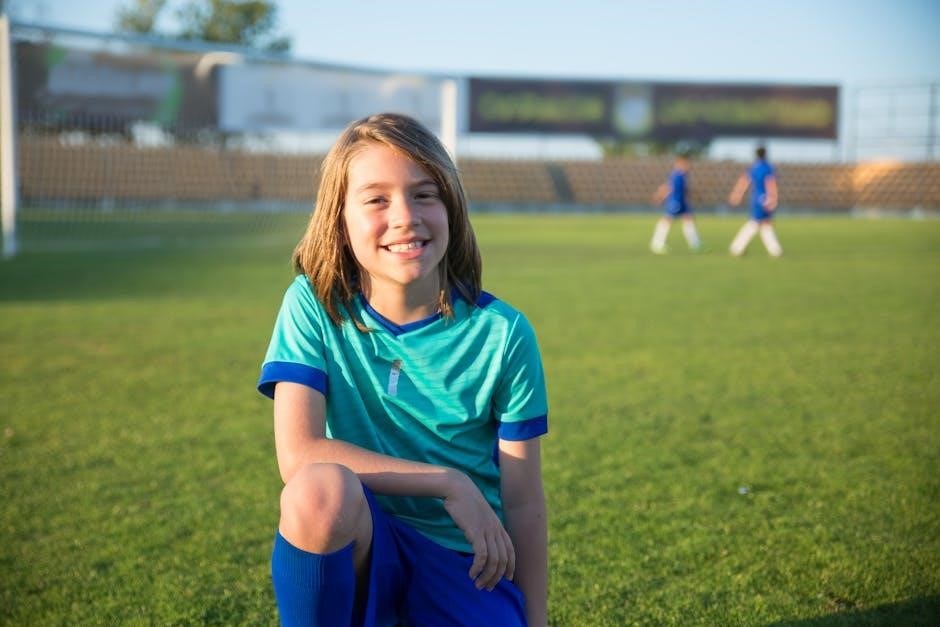
Breakaway and One-on-One Situations
Mastering breakaways and one-on-one scenarios is crucial for goalkeepers to prevent goals in high-pressure situations; Drills simulate attackers approaching the goal, requiring quick decisions and sharp reflexes to anticipate and block shots effectively.
8.1 Handling One-on-One Scenarios
Handling one-on-one situations requires goalkeepers to master positioning, decision-making, and quick reflexes. Drills involve simulating attackers approaching the box, forcing the goalkeeper to read body language and movement. Key skills include staying balanced, reducing the angle, and timing dives or blocks effectively. Coaches often use exercises where the attacker attempts to score from varying distances, while the goalkeeper practices cutting down the shooter’s options. These drills improve composure under pressure and the ability to make split-second decisions. Proper footwork and hand placement are emphasized to ensure effective saves and minimize recovery time.
8.2 Drills for Breakaway Saves
Drills for breakaway saves focus on simulating scenarios where the goalkeeper is isolated against an attacker. These exercises aim to improve reaction time, positioning, and the ability to make decisive actions. A common drill involves a striker sprinting toward the goal while the goalkeeper starts from a stationary position. The goalkeeper must explode forward, cut down the angle, and make a save. Another variation includes angled approaches, requiring the goalkeeper to shift sideways quickly. These drills emphasize explosive acceleration, proper diving technique, and effective glove work to secure the ball. They also help build confidence and decision-making in high-pressure situations.
Distribution and Communication
Effective distribution and clear communication are vital for goalkeepers to organize the defense and initiate counterattacks, ensuring seamless teamwork, maintaining possession, and enhancing overall performance.
9.1 Kicking and Throwing Techniques
Mastering kicking and throwing techniques is essential for goalkeepers to effectively distribute the ball and maintain possession. Techniques include instep kicks for distance, side-foot kicks for accuracy, and drop kicks for quick restarts. Throwing involves overarm throws for long distribution and rollouts for short, precise passes. Proper foot placement, body balance, and follow-through are key to consistency. Drills should focus on varying distances and pressures to simulate game scenarios, ensuring accuracy and power. These skills enable goalkeepers to act as playmakers, initiating attacks and relieving defensive pressure effectively.

9.2 Communication Drills with the Team
Effective communication is vital for goalkeepers to coordinate with their team. Drills should focus on vocal commands, such as directing defenders during crosses or calling for the ball. Role-playing scenarios, like simulating breakaways or set-pieces, help refine communication under pressure. Goalkeepers can practice shouting instructions clearly while teammates respond accordingly. These exercises build trust and ensure cohesive play. Drills should also include non-verbal cues, such as hand signals, to enhance coordination. Regular practice strengthens the goalkeeper’s leadership role, ensuring they can guide the team effectively during matches. Clear communication is key to organizing the defense and maintaining tactical discipline.
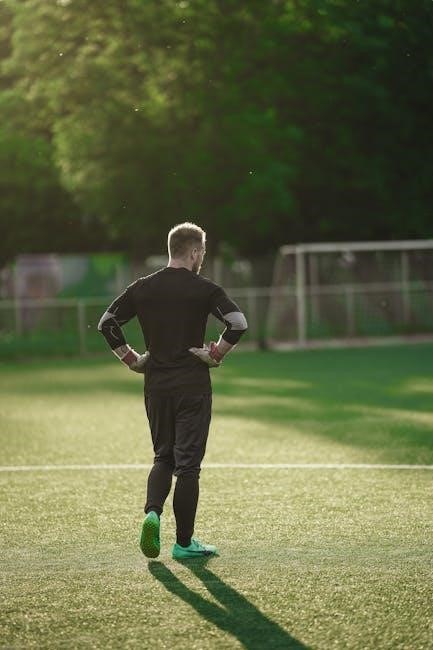
Cross and Corner Handling
Mastering cross and corner handling involves proper positioning, anticipation, and commanding the box. Goalkeepers should practice organizing their defense and timing their jumps effectively.
10.1 Dealing with High Balls and Crosses
Effectively managing high balls and crosses is critical for goalkeepers. Proper positioning, anticipation, and timing are essential to command the box confidently. Goalkeepers should practice catching, heading, and punching techniques to handle crosses from various angles and heights. Drills such as catching crosses from different delivery points, reaction ball exercises for unpredictability, and game situation simulations can improve decision-making and reflexes. Strengthening core and upper body strength also enhances stability when competing for high balls. Coaches should emphasize communication and organization of the defense to reduce confusion and ensure the goalkeeper is the dominant force in aerial duels.
10.2 Organizing the Defense for Corners
Organizing the defense for corners is a goalkeeper’s critical responsibility to prevent opposition scoring opportunities. The goalkeeper must communicate clearly, directing defenders to specific zones and marking opponents. Assigning roles such as near-post, far-post, and central defenders ensures coverage. Using zonal marking or man-to-man strategies depends on the team’s preference and opponent analysis. Goalkeepers should command the box, ensuring no unmarked players and minimal gaps. Drills simulating corner scenarios, with focus on positioning and communication, help build defensive cohesion. Maintaining a strong defensive shape and quick transitions after clearing the ball are equally vital to counter-attacks and maintaining pressure. Precision and teamwork are key.
Mental Preparation and Focus
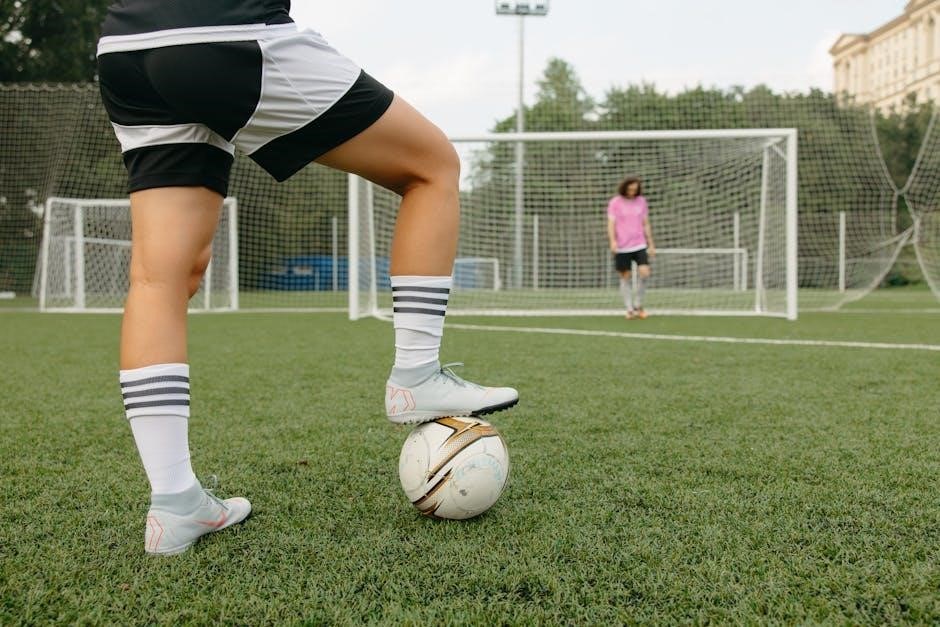
Mental preparation is vital for goalkeepers to stay calm under pressure. Visualization techniques, positive self-talk, and pre-game routines enhance focus and decision-making during matches; Consistency builds resilience.
11.1 Building Confidence in Goalkeepers
Building confidence in goalkeepers is essential for their performance. Positive reinforcement, such as praising efforts and successes, helps foster self-belief; Setting achievable goals and celebrating progress boosts morale. Specific drills, like breakaway saves and one-on-one scenarios, simulate game pressure, allowing keepers to succeed in realistic situations. Visualization techniques, where keepers mentally rehearse saves, also enhance confidence. Consistent training routines and game-like simulations provide a sense of preparedness. Encouraging a growth mindset and focusing on effort rather than outcome helps keepers embrace challenges and learn from mistakes, leading to improved resilience and belief in their abilities during critical moments.
11.2 Mental Exercises for Improved Focus
Mental exercises are crucial for sharpening a goalkeeper’s focus. Techniques like visualization and mindfulness can enhance concentration. Goalkeepers should practice visualizing game scenarios, such as saving penalties or handling crosses, to stay mentally sharp. Meditation and breathing exercises can help maintain calm under pressure. Focusing on a pre-save routine, like deep breathing or positive self-talk, improves consistency. Additionally, keepers can use mental rehearsal to anticipate opponents’ moves, fostering better decision-making. These exercises train the mind to stay present and react decisively, ensuring peak performance during critical moments. Regular mental drills build resilience and enhance the ability to maintain focus throughout the game.
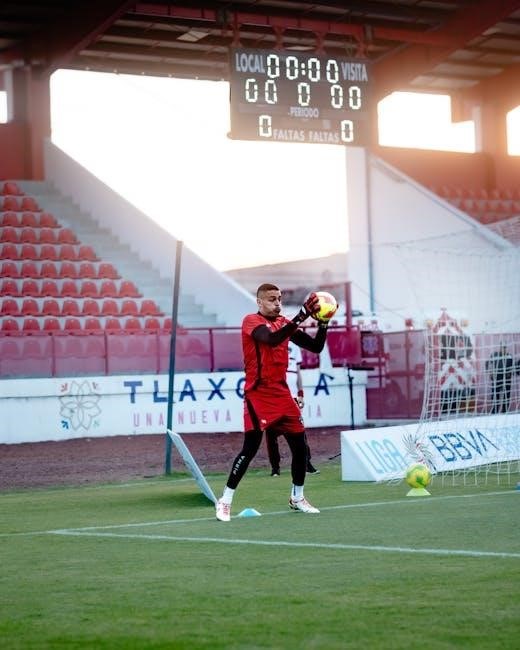
Cool Down and Recovery
A proper cool-down after training prevents injury and aids recovery. Focus on stretching major muscle groups, light cardio, and foam rolling. Incorporate ice baths for muscle repair and relaxation to ensure optimal recovery and preparedness for the next session.
12.1 Stretching Exercises for Goalkeepers
Stretching is crucial for goalkeepers to maintain flexibility and prevent injuries. Focus on dynamic stretches like leg swings, lunges, and hip circles to improve range of motion. Include hamstring stretches to protect the lower back and hip flexor stretches to enhance agility. Incorporate side stretches and shoulder rolls to maintain upper body flexibility. Emphasize calf stretches to support explosive movements. Use static stretches post-session for muscle recovery, holding each stretch for 20-30 seconds. Prioritize areas like quadriceps, groin, and lower back to ensure optimal mobility and injury prevention. A consistent stretching routine enhances performance and supports long-term durability for goalkeepers.
12.2 Recovery Techniques for Optimal Performance
Proper recovery is vital for goalkeepers to maintain peak performance and prevent injuries. Techniques include foam rolling, ice baths, and compression garments to reduce muscle soreness. Incorporate post-training massages to improve circulation and relax tense muscles. Hydration and nutrition play a key role, with protein-rich meals and electrolyte replenishment essential for muscle repair. Light swimming or cycling can enhance active recovery by promoting blood flow without overexertion. Prioritize sleep, aiming for 7-9 hours nightly, to allow the body to fully recover. These methods ensure goalkeepers return to training refreshed, ready to perform at their best, and maintain long-term physical health.